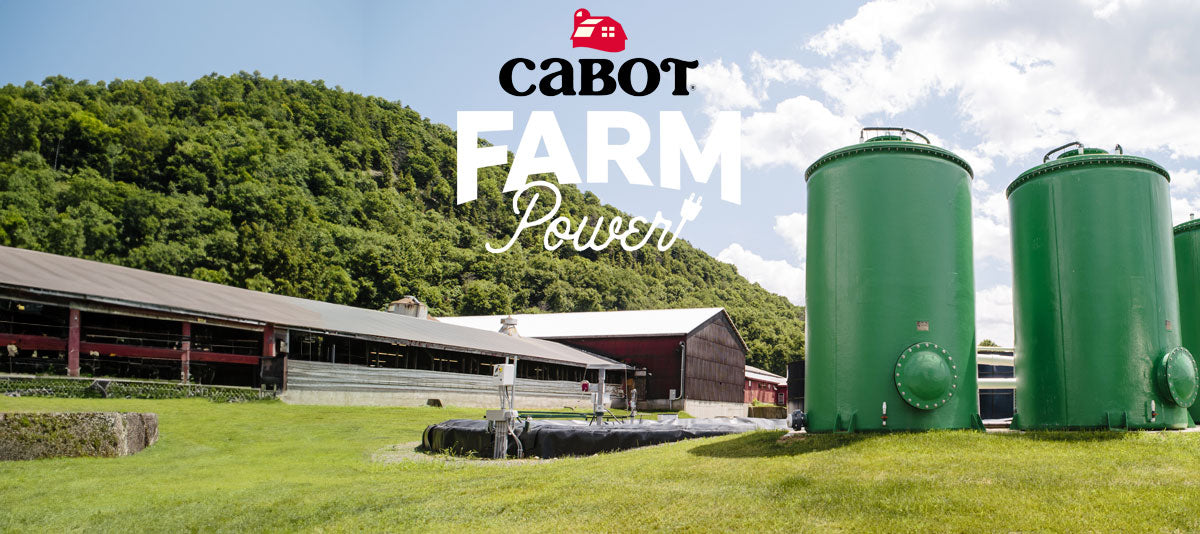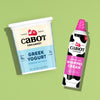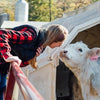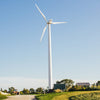
World's Best Butter is Created with Real Farm Power
At Cabot Creamery, we’re honored that our butter was named World's Best when it took first place at the World Championship Cheese Contest in 2024. We’re even more proud of the reason for it. Every day, our cooperative of farm family owners are committed to caring for their animals and their land. Their stewardship is one of the key ingredients that make our dairy products the most delicious on the market.
But there’s another aspect of our award-winning butter that’s worth talking about: The energy required to produce it. That’s where Barstow’s Longview Farm in Hadley, Massachusetts comes into the picture. This long-time cooperative member generates enough electricity on their farm to churn every single stick of Cabot butter.
From Waste to Resource
Barstow’s is a seventh-generation dairy farm that has embraced continuous improvement for more than two centuries. In fact, the farm motto is ‘looking forward since 1806.’
“The motto is our commitment and our reminder to our team every single day: To take care of our herd, our land, our workforce, our community, and our food system,” said Denise Barstow-Manz, the farm’s Marketing and Education Manager.
Barstow’s exemplifies these principles with conscientious land stewardship and innovative farm practices. Cows stroll up to robot milkers whenever the impulse strikes them and eat high-quality forage that’s harvested on the farm.
In the late 2000s, the family decided to pursue renewable energy generation when plummeting milk prices led many dairy farmers to explore new business models.
“We really needed to diversify and bring in additional revenue streams if we were going to continue farming,” said Denise.
The Barstows learned that an anaerobic digester tank could convert their cow manure and other organic waste to renewable energy, which could then be sold to a utility. After securing funding and partnerships to get the project off the ground, they installed a digester on the farm in 2013. Vanguard Renewables manages the digester, freeing up the Barstows to focus on the health of their herd and feed.

The digester helped the Barstows achieve their financial goals, and then some: They now have a regular, reliable source of income from their electric utility and from the local businesses who pay tipping fees to dispose of their food waste. The heat created by the digester also warms the farm’s eight living quarters, eliminating heating bills. And the nutrient-rich digestate left over in the tank is spread across the farm’s forage crop fields, dramatically minimizing the use of purchased fertilizer.
In addition to financial benefits, the Barstows have reduced their greenhouse gas emissions—the digester takes the equivalent of 650 cars off the road each year—and improved the farm’s soil quality. The forage crops are healthier, the herd is healthier, and the community benefits, too.
“We didn't want to diversify in a way that didn't add a lot of value to our community. This is something that is diverting food waste from landfills. It's lessening our carbon hoof print and it really does fit in well with our community,” said Denise.
Creating a Closed Loop System
The Barstow’s digester is a testament to the beneficial role innovative technology can play in dairy farming today. Each year, it breaks down 9,125 tons of cow manure from the farm’s 600 cattle and 14,000 tons of food waste from nearby businesses and institutions.

One of the first companies to transport its food waste to the Cabot member farm? Cabot Creamery, of course.
We make all of our butter in West Springfield, Massachusetts—just 15 miles down the road from the Barstows. We began diverting organic waste to the digester instead of our municipal wastewater treatment plant..
“Essentially, we're able to upcycle something that had been thought of merely as waste into something that ultimately turns into renewable energy. I think that's really cool,” said Jed Davis, Cabot’s VP of Strategic Engagement & Sustainability.
Soon after, we began purchasing farm-powered electricity from our local utility. We use it to power some of our creamery operations, including all the electricity needed to churn our world-famous butter. The agreement helps Cabot support a member farm while also meeting its sustainability goals as a certified B Corp.
“Any time we can have a sustainability win that involves co-op members and our commercial team, and it benefits our customers and is exciting to our consumers: We’ll take it! Solutions that have positive impacts on all quadrants… that’s what we live for,” said Jed.
From cow to butter to fertilizer to cow, the closed loop we’ve created with the Barstows shows what’s possible when people work together to solve shared challenges.

“I was just so delighted that Cabot was so engaged and interested in making sure that this connection existed. It speaks volumes to the value that Cabot has in sustaining their local farms and in lessening their carbon hoof print,” said Denise.
Doing Better Tastes Better
The rich and creamy flavor of Cabot butter means it won’t last long on your table. But with the help of the Barstow’s agronomic practices and innovative technology, it does help our farms and environment endure.

“Our mindset is that we're just sort of borrowing the farm from the next generation. We're making decisions for the eighth generation, because they're the ones who will inherit this land and inherit this business,” said Denise.
We’re proud to support the Barstows and all our member farms, each improving its sustainability in different ways. And as for the butter? We think our farmers’ mindset makes it taste all the better.


















